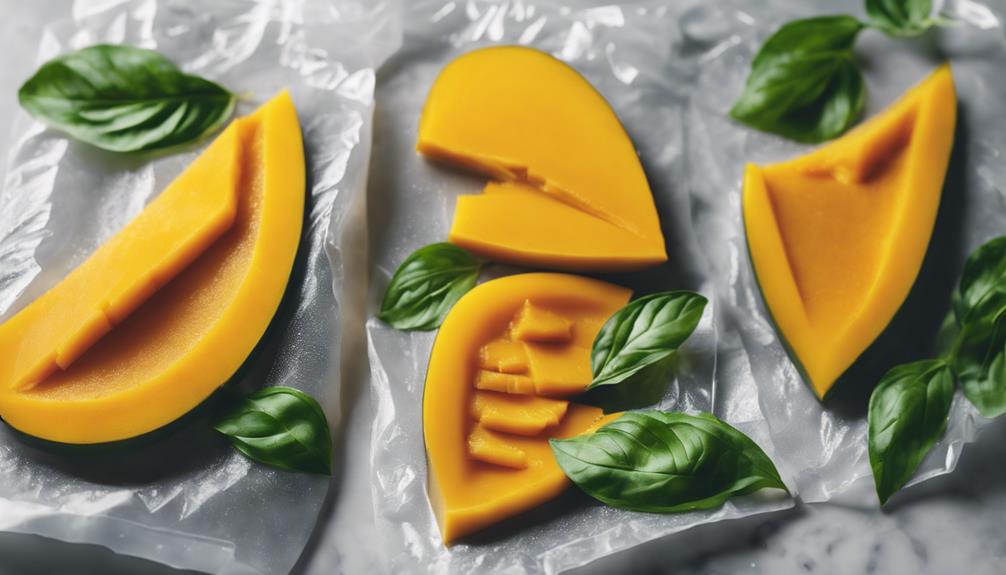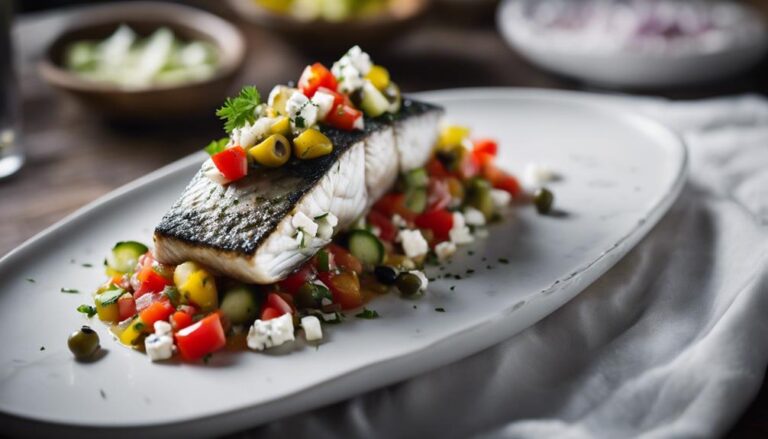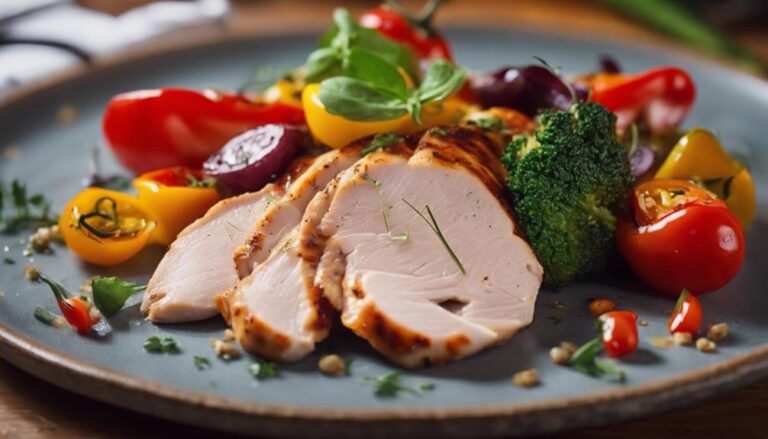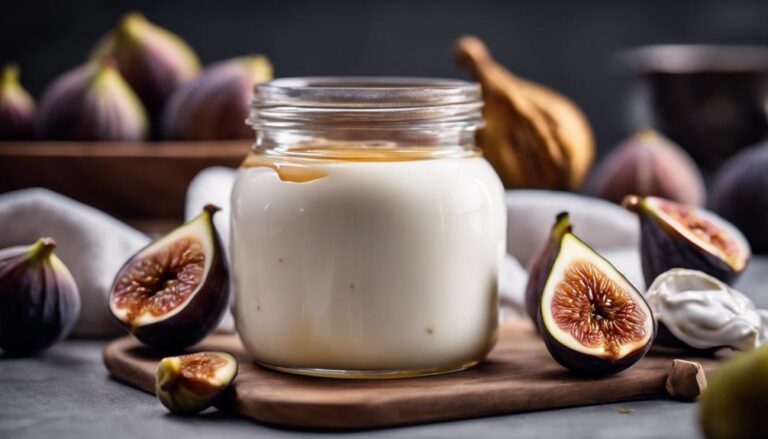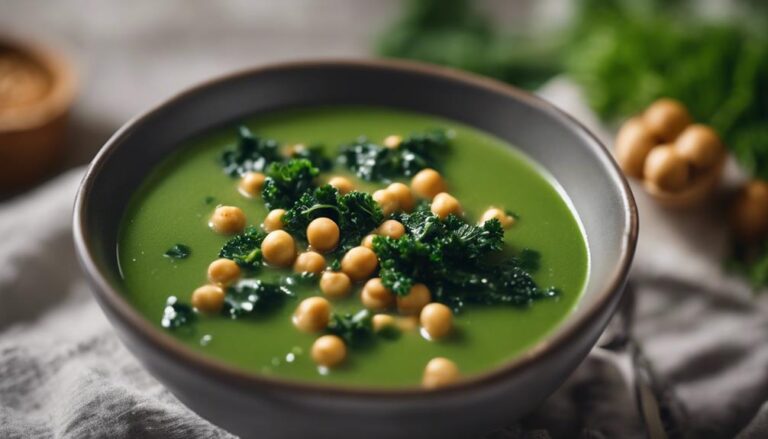Sous Vide Mango With Basil
Experience the exquisite blend of flavors in sous vide mango with basil. Set the sous vide to 135°F (57°C) for 45 minutes for perfect tenderness. The vacuum-sealed bags lock in moisture and preserve nutrients, ensuring a burst of tropical goodness. Basil's fresh complexity enhances mango's sweetness, offering a unique taste sensation. Elevate your culinary skills with this harmonious dish that balances texture and taste flawlessly. Get ready to savor a delightful fusion of tropical sweetness and fresh basil complexity!
What You Will Learn Here
- Sous vide mango at 135°F with basil for 45 minutes for optimal flavor.
- Vacuum-sealed bags preserve mango's sweetness and basil's freshness.
- Precision cooking techniques ensure texture and taste perfection.
- Basil adds complexity and freshness, enhancing mango's natural sweetness.
- Infusion of basil elevates mango dish, creating a harmonious blend of flavors.
Mango's Origins
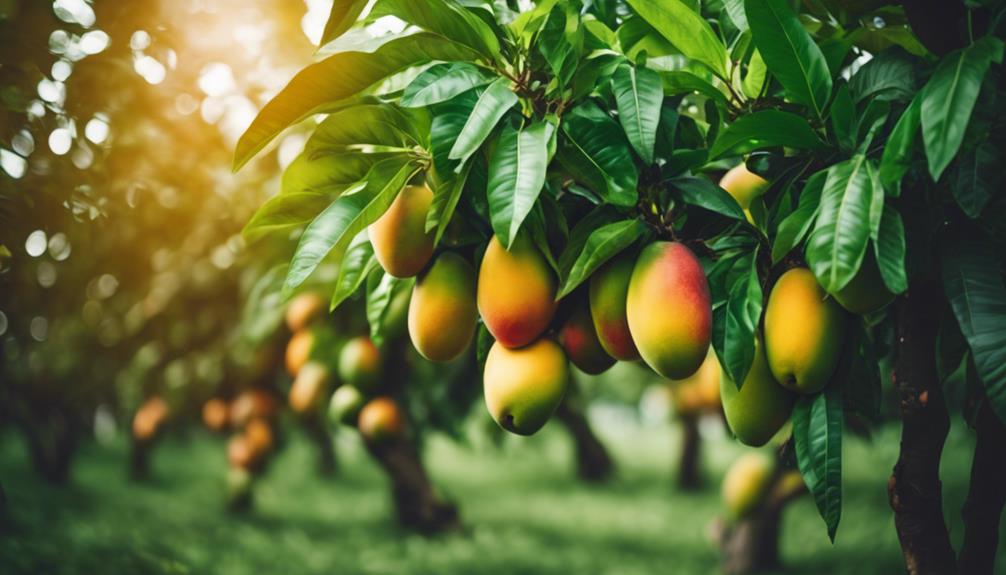
Mango's tropical roots trace back to Southeast Asia, where it was first cultivated centuries ago.
Historical records highlight the significance of mango cultivation throughout various cultures and regions.
Understanding the cultural importance of mango can provide insights into its enduring popularity and widespread consumption.
Mango's Tropical Roots
With origins rooted in the tropical regions, mangoes have a rich history that dates back centuries. Mango cultivation has been a significant part of tropical agriculture for ages, with these luscious fruits thriving in warm climates worldwide. The tropical flavors of mangoes, with their sweet and tangy notes, evoke images of sunny beaches and lush landscapes.
Mangoes are believed to have originated in South Asia, with India being one of the first countries to cultivate them. The spread of mango cultivation across the globe was facilitated by traders and explorers who recognized the value of these delectable fruits. As mangoes became popular in various regions, their tropical essence became synonymous with relaxation and indulgence.
Today, mangoes are enjoyed in diverse culinary creations, from invigorating smoothies to exotic salads. Their tropical roots continue to inspire chefs and food enthusiasts, showcasing the versatility and irresistible appeal of this beloved fruit. Whether eaten fresh or incorporated into dishes, mangoes bring a taste of the tropics to tables around the world.
Historical Mango Cultivation
Thriving in tropical climates, mango cultivation has a rich historical legacy that traces back centuries. The practice of growing mangoes dates back to ancient times, with historical records revealing various mango cultivation techniques and practices used by different civilizations. In regions like South Asia and Southeast Asia, where mangoes originated, farmers developed sophisticated methods to cultivate and propagate these delicious fruits. They honed their skills in grafting, pruning, and soil management to improve mango yields and quality.
The historical significance of mango cultivation is also tied to trade routes and ancient markets. Mangoes weren't only cherished for their taste but also valued for their economic importance. Along the Silk Road and maritime trade routes, mangoes were traded, introducing different varieties to new regions and cultures. Ancient markets bustled with activity as merchants sold ripe mangoes, showcasing the fruit's desirability and versatility.
Understanding the historical practices of mango cultivation provides insight into how this beloved fruit became a staple in many cuisines worldwide.
Cultural Significance of Mango
Having roots in ancient civilizations, the mango holds profound cultural significance, tracing its origins back to regions like South Asia and Southeast Asia. Mango symbolism is prevalent in various cultures, representing love, fertility, and even immortality. In South Asian countries like India and Pakistan, the mango tree is often associated with prosperity and is considered sacred. Cultural practices such as offering mangoes during religious ceremonies or using mango leaves in decorations showcase the fruit's revered status.
Mango festivals and traditional celebrations further highlight the fruit's importance. In India, the annual Mango Festival in Delhi attracts visitors from around the world to indulge in a variety of mango cultivars and dishes. These festivals not only celebrate the fruit's delicious taste but also honor its cultural significance in the region. Traditional dances, music, and art often accompany these events, creating a vibrant atmosphere that pays homage to the beloved mango. Overall, the cultural significance of mangoes continues to be cherished and celebrated in various communities worldwide.
Key Ingredient Pairings
To enhance the flavors of sous vide mango, consider carefully selecting complementary ingredients that will elevate the dish to new heights. Here are some key ingredient pairings that can take your sous vide mango with basil to the next level:
- Fruit Pairings: Pairing mango with other fruits like pineapple, strawberries, or kiwi can add a delightful mix of sweet and tangy flavors. These fruits complement the tropical essence of mango, enhancing its natural sweetness.
- Herb Combinations: Basil is a classic herb that works wonderfully with mango, but you can also experiment with mint, thyme, or even a hint of cilantro for a different flavor profile. These herb combinations can add depth and freshness to the dish, balancing the sweetness of the mango.
- Taste Balance: Consider adding a touch of lime juice for a hint of acidity to balance the sweetness of the mango. This addition can bring a zesty brightness to the dish, enhancing its overall flavor profile.
- Texture Contrast: Incorporating ingredients like toasted coconut flakes or chopped nuts can provide a textural contrast to the softness of sous vide mango, adding crunch and richness to each bite.
Trending Mango Dishes
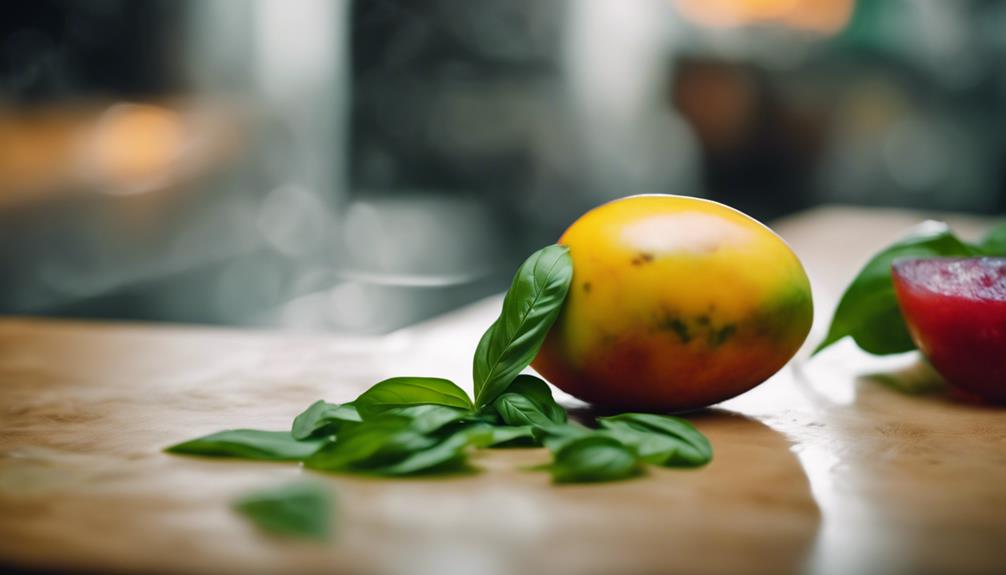
If you're looking to stay on top of the latest mango trends, consider trying out some of these popular dishes:
Mango Sorbet With Spicy Kick, Spicy Mango Salsa, and Mango and Coconut Popsicles.
These creations showcase the versatility of mango in both sweet and savory applications.
Whether you're a fan of spicy flavors or prefer a tropical twist, there's a trending mango dish out there for everyone.
Mango Sorbet With Spicy Kick
For an invigorating and bold twist on classic mango sorbet, consider adding a spicy kick to elevate the flavors. Here are some tips to help you create a Mango Sorbet With a Spicy Kick:
- Choose Ripe and Sweet Mangoes: Opt for ripe and sweet mangoes to guarantee the sorbet has a natural sweetness that balances well with the spiciness.
- Add a Dash of Cayenne Pepper: Sprinkle a dash of cayenne pepper into the sorbet mixture to infuse a subtle heat that complements the mango's sweetness.
- Lime Juice for Zing: Squeeze fresh lime juice into the sorbet mix for a citrusy zing that brightens the flavors and enhances the overall taste.
- Garnish with Fresh Mint: Garnish your mango sorbet with fresh mint leaves to add a rejuvenating coolness that contrasts beautifully with the spicy kick.
Spicy Mango Salsa
Elevate your taste buds with the zesty and invigorating flavors of Spicy Mango Salsa, a trending dish that combines the sweetness of mangoes with a fiery kick.
- Fruit pairing: The juicy sweetness of ripe mangoes pairs perfectly with the tangy notes of other fruits like pineapple or lime, adding complexity to the salsa.
- Spicy condiments: Incorporating spicy elements like jalapeños, chili flakes, or a dash of hot sauce brings a delightful heat that contrasts beautifully with the mango's natural sugars.
- Texture contrast: Chopped onions, bell peppers, or cucumbers provide a crunchy texture that enhances the overall mouthfeel of the salsa.
- Balancing flavors: A squeeze of fresh lime juice and a sprinkle of salt help balance the sweetness of the mango while enhancing the other flavors in the salsa.
Whether served with tortilla chips, grilled fish, or tacos, this Spicy Mango Salsa is a versatile and invigorating addition to your culinary repertoire.
Mango and Coconut Popsicles
Indulge in the tropical delight of Mango and Coconut Popsicles, a rejuvenating treat perfect for sunny days.
- Refreshing Combination: These fruit popsicles offer a delightful mix of sweet mango and creamy coconut, creating a burst of tropical flavors in every bite.
- Easy Homemade Option: Making your own tropical desserts at home is simple with just a few ingredients like fresh mango, coconut milk, and a touch of honey.
- Healthy Alternative: Enjoy a guilt-free indulgence with these popsicles that are free from artificial additives, making them a wholesome option for a satisfying dessert.
- Cooling Summer Treat: Beat the heat with these frozen delights that aren't only delicious but also help you stay refreshed during hot summer days.
Whether you're looking for a cooling snack or a light dessert, Mango and Coconut Popsicles are a fantastic choice. So, grab your popsicle molds, blend up a tropical mixture, and freeze your way to a taste of paradise.
Sous Vide Temperature Recommendations
When it comes to sous vide cooking, it's essential to pay attention to the recommended temperatures. These temps aren't just numbers; they guarantee your food is cooked precisely and retains its quality.
Optimal Sous Vide Temps
For best results when cooking sous vide mango with basil, it's important to adhere to specific temperature recommendations. When preparing sous vide fruit, such as mango, precise temperature control is key to achieving the desired texture and flavor. Sous vide cooking methods involve sealing ingredients in a vacuum-sealed bag and cooking them in a water bath at a consistent low temperature for an extended period.
To ensure the ideal sous vide temps for mango with basil, set your sous vide water bath to around 135°F (57°C). This temperature allows the mango to soften and infuse with the basil flavors slowly, resulting in a delicate and perfectly cooked fruit. Cooking the mango at this temperature for approximately 45 minutes to 1 hour will enhance its natural sweetness and preserve its nutrients.
Maintaining the recommended sous vide temperature is essential for sous vide fruit dishes like mango with basil as it ensures even cooking without the risk of overcooking or losing essential flavors.
Precision Cooking Techniques
To achieve precise cooking results in sous vide preparation, maintaining the suggested temperature is crucial for excellent flavor and texture. Temperature control is a fundamental aspect of sous vide cooking.
The recommended temperature for cooking mangoes sous vide is around 135°F (57°C) for 45 minutes. This precise temperature guarantees that the mangoes are perfectly cooked without losing their natural sweetness and texture.
Cooking precision is key when using sous vide techniques. It allows you to have full control over the cooking process, resulting in consistent and delicious outcomes every time.
Maintaining Food Quality
Maintaining peak food quality in sous vide cooking involves adhering to specific temperature recommendations. Food preservation and flavor retention are key factors in guaranteeing your dishes turn out perfectly. By cooking your ingredients at precise temperatures for a controlled amount of time, you can uphold the integrity of the flavors and textures in your food.
Sous vide cooking provides an excellent way to preserve the nutrients and natural juices in your ingredients. The vacuum-sealed bags lock in moisture, preventing the loss of essential vitamins and minerals during the cooking process. This method also helps in retaining the natural colors and flavors of the food, resulting in vibrant and delicious dishes.
With sous vide, you have precise control over the cooking temperature, allowing you to achieve the exact level of doneness you desire. Whether you prefer a tender and juicy texture or a firmer bite, sous vide enables you to cook your food to perfection every time. By following recommended temperature guidelines, you can make sure that your sous vide mango with basil is a delightful and flavorful dish that showcases the benefits of cooking with precision.
Final Thoughts

Considering all the flavors and textures that have come together in this sous vide mango with basil dish, it's evident that each component has been elevated to its fullest potential. The flavor combinations achieved through the sous vide cooking method have allowed the mango to reach a level of sweetness and tenderness that's unparalleled. The slow, precise cooking technique of sous vide has enabled the mango to absorb all the flavors from the basil, creating a harmonious blend of fruity sweetness with a subtle hint of herbaceous freshness.
Moreover, the texture control provided by the basil in this dish adds a layer of complexity that elevates the overall dining experience. The delicate leaves of basil, when infused with the mango during the sous vide process, impart a soft yet distinct texture that complements the melt-in-your-mouth consistency of the fruit.
Frequently Asked Questions
Can Sous Vide Mango Be Frozen for Later Use?
Yes, you can freeze sous vide mango for later use. The freezing process helps preserve its flavors. It's perfect for creating invigorating smoothies or incorporating into fruit salads. Don't forget to seal it properly for the best results.
How Long Does It Take to Sous Vide Mango?
To achieve ideal texture, sous vide mango typically takes 45-60 minutes. This method allows for thorough flavor infusion. Your patience will be rewarded with perfectly cooked mango that's bursting with deliciousness. Enjoy the sweet results!
Can Other Herbs Be Used Instead of Basil?
You can certainly use other herbs instead of basil in your recipe. Consider rosemary as a substitute or cilantro as an alternative. Thyme pairs well with many dishes, and mint can infuse a rejuvenating flavor into your creations.
Is It Necessary to Peel the Mango Before Cooking?
You don't have to peel the mango before sous vide cooking. The skin can enhance the flavor and texture. It's a personal preference, but many find it adds complexity to the dish. Experiment to find what you like best.
Can Sous Vide Mango Be Used in Savory Dishes?
Yes, sous vide mango can enhance savory dishes like mango salsa or a savory mango salad. Its tender texture and concentrated flavor make it a versatile ingredient that adds a unique twist to your recipes.
Conclusion
To sum up, sous vide mango with basil is a delicious and trendy dish that's easy to prepare using the right temperature recommendations.
By combining the sweet and tropical flavors of mango with the fresh and aromatic taste of basil, you can create a unique culinary experience that's sure to impress.
Whether you're a seasoned chef or just starting out in the kitchen, this dish is a must-try for anyone looking to explore new and exciting flavor combinations.
